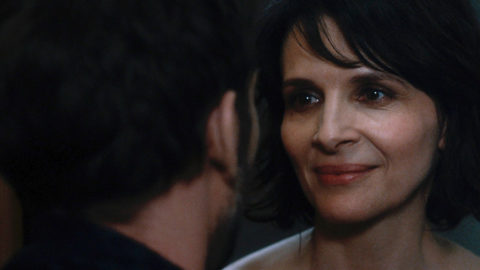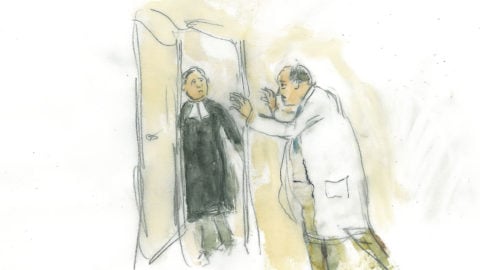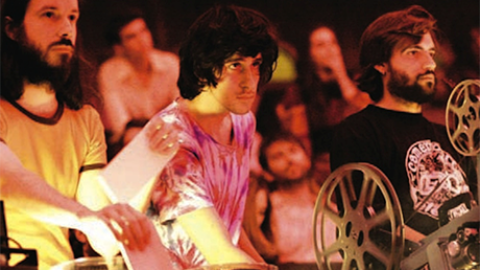By Aliza Ma in the May-June 2019 Issue
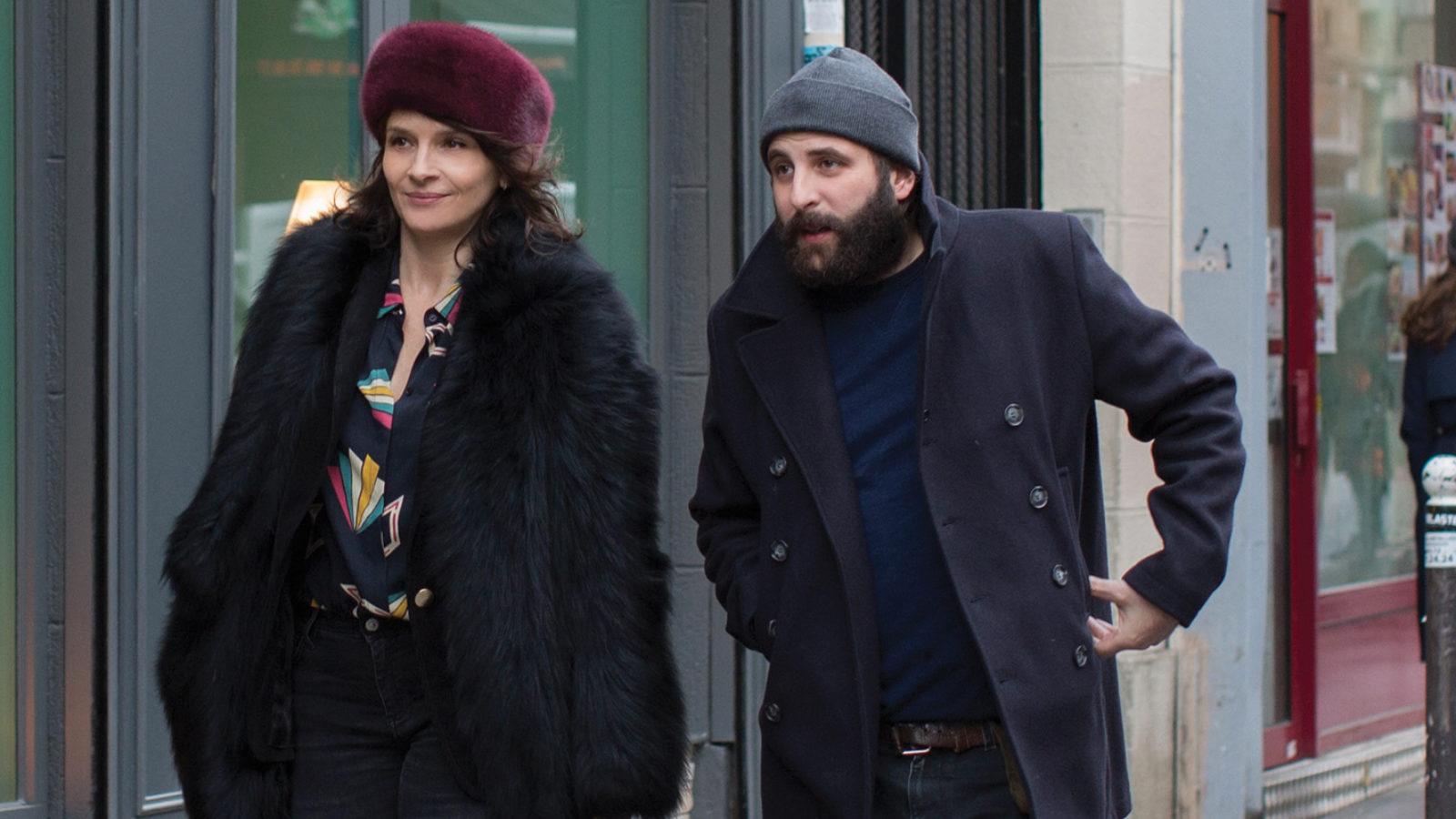
Truth or Consequences
With Non-Fiction and its hapless Paris smart set, Olivier Assayas sets his galaxy brain to work on the shifting sand and mirages of the vaunted digital age
In the cinema of Olivier Assayas, we find a laboratory of the world. His ’90s features Cold Water (1994), Irma Vep (1996), and Late August, Early September (1998) were made on Super 16mm to liberate filmmaking from the weight of unwieldy state-of-the-art technologies of the day, forging an intuitive, naturalistic style that gave way to more direct explorations of autofiction, metafiction, and melodrama. This self-conceived freedom has manifested in vastly dissonant genres, shape-shifting in atmosphere, form, and format. Demonlover (2002) exploded the all-pervasive sense of perilous Y2K doom into a series of S&M-inflected exploits crosshatching the globe, while in the quietly heart-wrenching mid-career Summer Hours (2008), a rumination on heirlooms left behind by a deceased matriarch served to condense collective memories and familial history and distill the murky liminality and perishability of lived time into scenes of elegant bucolic beauty. Anticipating the age of auteurist television, Carlos (2010) extrapolated the singular figure of Venezuelan terrorist Carlos the Jackal into a six-hour espionage thriller, canvassing domestic, civic, and geopolitical strata, and hewing its contours to the sprawl of historical transition during the Cold War. Throughout this varied career, Assayas’s cinema has remained ensconced in deeply humanist contemplations of the way people relate to one another and their environments, propelled by a razor-sharp inquisitiveness toward ever-changing cultural and technological landscapes.
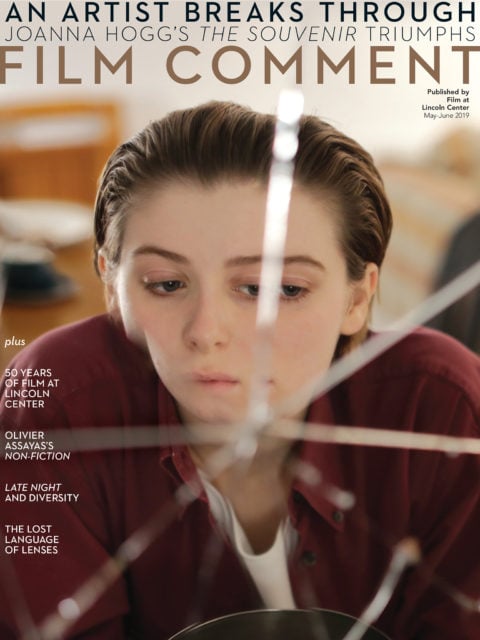
From the May-June 2019 Issue
Also in this issue
Underlying these audacious forays into genre experimentation are often subtle essayistic studies of how aesthetic, ideological, and political identities modulate with the passage of time. Sometimes this occurs in subtext, as in Irma Vep, which coded Assayas’s complex ideas of film theory in a metafictional reworking of Louis Feuillade’s Les vampires; and sometimes it’s explicit, as in Something in the Air (2012), which recollected and reinvestigated the turbulent political climes of the 1970s of Assayas’s youth, when every established notion of society was being challenged and reinvented. A question asked by the writer-editor Gabriel (Mathieu Amalric) in Late August, Early September—can stories “describe the world”?—perfectly encapsulates Assayas’s manner of working, two decades on. His last two films, Clouds of Sils Maria (2014) and Personal Shopper (2016), both deconstructed backstage dramas depicting a globalized entertainment industry in flux, were calibrated to the extreme present-tense, interrogating the dilating expanse between poles of individual existence and nature (and in the case of Personal Shopper, even the supernatural) brought on by the post-Internet era.
Non-Fiction, Assayas’s newest, is a delicate melodrama following the interwoven lives of two couples immersed in the smart set of Paris’s cultured class. Initially written as a series of dialogues assaying the inertia of a post-digital world, the film follows a few main characters: Alain Danielson (Guillaume Canet), an editor at a prolific and, until recently, successful publishing house; his wife, actress Selena (Juliette Binoche), who is currently starring as a TV cop in a hit series hilariously titled Collusion; Léonard Spiegel (Vincent Macaigne, also a seasoned theater director and actor in Paris), a novelist known for his barely veiled romans à clef that incorporate salacious details about his real-life affairs; and his longtime partner Valérie (Nora Hamzawi, another prolific stage actor in her first major film role), who is assiduously working the campaign trail for a leftist politician. Assayas eschews a dominant narrative arc for a series of vignettes depicting intimate conversations among these characters set in the city and the country, in public and domestic spheres, often over food and drink, in which their (and presumably Assayas’s own) speculations around their relationships to each other, their professions, and their place in the world—regarding art, criticism, nature, and ever-increasingly, the Internet—are taken up.
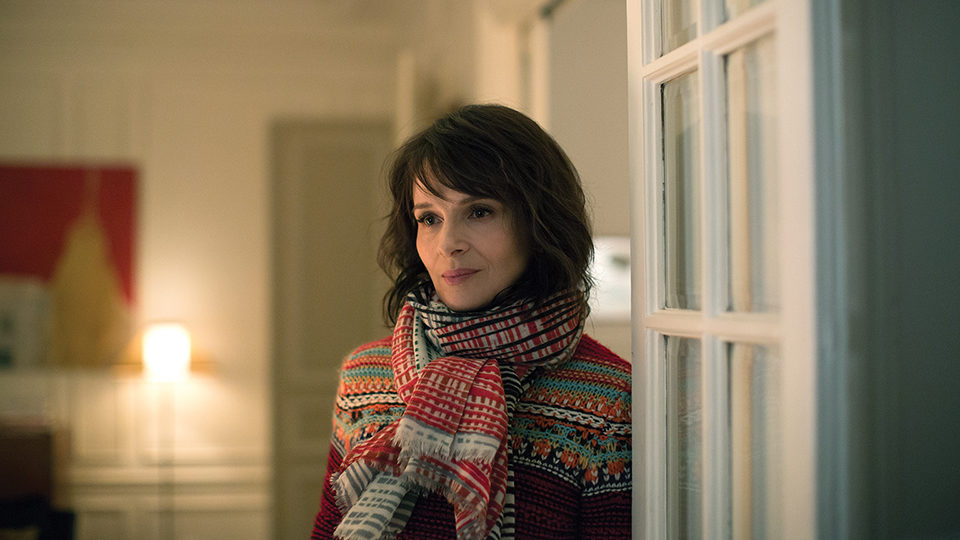
Non-Fiction (Olivier Assayas, 2018). Courtesy of IFC Films
In Non-Fiction, the uncertainties and anxieties of our current moment feed the existential impasses experienced by the characters. Despite having hired a young millennial named Laure (Christa Théret) to oversee the company’s “digital transition,” Alain—whose office and home are lined floor to ceiling with novels—is having a hard time reconciling the rapid digital transformations of his industry with his faith in the auratic quality of the physical medium of books, in which he has always anchored his passion and career. Selena’s current TV gig has left her longing for artistic fulfillment—she wants to play Phaedra in a theatrical production—yet she has never been more successful in the eyes of the public and her peers. Léonard, who had been content living as a Luddite monomaniacally focused on his writing, has just had his latest manuscript rejected by his longtime friend and publisher Alain. Blissfully unaware of mounting animosities on social media toward the depictions of his real-life relationships, he’s ambushed by an impertinent public, first at a local book signing and Q&A and then at a public radio interview. Meanwhile, it is revealed that Selena and Léonard have been carrying on an affair for years, as Alain begins a series of trysts with Laure. Compared to these other characters’ ivory-tower existences, Valérie’s work is fixed in the “real world” of face-to-face communication and low-to-the-ground grassroots outreach, driven by her progressive ideology. But her high-minded intellectual friends dismiss her conviction to improve the world through political action, and her hard work is circumvented by her own boss when his scandalous dealings with a prostitute are disclosed by prying reporters.
Non-Fiction functions as a kind of workshop of Assayas’s own cinematic past, bearing explicit and implicit callbacks to themes and motifs undertaken throughout its director’s filmography, and a way of working through his preoccupations with the current state of the world—much of the rapid-fire dialogue sounds like discourses taken directly from his own thoughts—bringing forth inquiries into the uncertainties percolating through these time of unrest and flux. While the French title of the film, Doubles vies (“Double Lives”), seems to call back to the feature preceding Cold Water, Une nouvelle vie (1993), the roundelays of Rohmerian-inflected conversation in Non-Fiction resonate with and reflect upon the chaos of the present moment in the manner of Late August, Early September. Shot on Super 16mm like his early features, his new film bears a fluid effortlessness and sprightly effervescence in contrast to the sleek polish of his last two films. It marks the first time Assayas has leaned so directly into the comedic genre, and parallel to the way that Irma Vep’s playful, beguiling formal qualities scaffolded the filmmaker’s complex ideas about film theory, Non-Fiction folds deeply existential questions about our present and future into more digestible modes of witty banter, bringing the abstract and philosophical down to a scale of the concrete and tangible.

Non-Fiction (Olivier Assayas, 2018). Courtesy of Ad Vitam
As in Personal Shopper, which gave us the indelible image of Kristen Stewart exchanging iMessages with a (maybe) ghost—one would be hard pressed to find another contemporary auteur with a more galaxy-brained approach to incorporating texting and social media into the framework of filmmaking—cell-phone communication functions both as a narrative motif and storytelling device in Non-Fiction. Meanwhile, the scenes of Selena on the set of Collusion—by appearances a boilerplate Netflix Original–esque police thriller—slyly recall critical responses to Carlos and the early debates of TV vs. cinema that surrounded its release. This playful self-reflexivity throughout the film is topped with a chef ’s kiss when Juliette Binoche gets checked by name in the dialogue of the final scene, when the topic of a celebrity narrator for Léonard’s new e-book—to boost online sales—is being discussed by the two couples.
At a dinner party earlier in the film, someone wonders aloud if Theodor Adorno’s ideas would be equally potent in an e-book as on vellum paper. Though the distinct analog texture of film grain still provides the delivery format for these debates, such medium/message questions form much of the fodder for discussion throughout Non-Fiction. After going to a conference— beset with haunting futility, larded with forecasts about the “future of the industry,” capped by sparsely attended humdrum Q&A sessions that anyone who has ever attended an industry conference or film festival will recognize—Alain and Laure debate the virtues and disadvantages of analog versus digital in the publishing world. Laure is precocious, bisexual, and libertarian in her views of an all-usurping metric-driven media landscape of production and consumption (“tweets are like modern-day haikus,” she tells Alain); accordingly, she posits that in the face of an inevitable digital takeover it would be better to be on the side of change, rather than fall victim to it. Her femme fatale quality would be right at home in Carlos, and her brand of future-focused, internationally mobilized cosmopolitanism is straight out of Personal Shopper. Single-handedly opening up a schism in a milieu of established middle-agers, she looms as an ominous voice of the future, portending the capsizing of all previously established cultural standards people like Alain helped to build.
Laure refers to the iconic quote from Visconti’s The Leopard, that “everything needs to change, so everything can stay the same.” But Alain invokes Bergman’s Winter Light, about a pastor who holds services in the empty church of an abandoned town: “it’s about faith.” And perhaps faith—like analog media—which can never be reduced to zeros and ones, is the last refuge for those who reject being complacent in the face of shifting economic forces, and fuel their aspiration to continue being custodians of ideas that should always transcend the steamroller of changing technological and industry standards. Whether the digital revolution has taken us past a point of no return or the pendulum might swing back for future generations—in publishing, film, and the “real” world—is a central, urgent, yet unresolved question hanging in the air of Non-Fiction.
Notions of authenticity—a word that has been abused and turned inside-out to the point of abjuration—of art in the age of endless digital reproduction might seem like a 2.0 rehashing of debates that have plagued thinkers for nearly a century (most notably the exchanges between Adorno and Walter Benjamin). But what the last two years have revealed, beyond aesthetic spheres, and what Assayas distills in Non-Fiction, is the daunting way in which established cultural norms can be reduced to abstracted gossamer-thin notions to be endlessly debated and turned over, eclipsing any determinable action that could herald true progress. Not unlike the 1970s of his youth as depicted in Something in the Air—when all barriers and definitions were broken down, and it seemed everything had to be built up again—our current era, which Léonard calls a world of “post-truth,” offers its own sense of being trapped between a stagnant past and unknown future. It’s underscored by the characters’ Twilight Zone–like conversations about the daunting fragility of established structures and categories that form the bedrock for individual identities: how can art, life, and criticism feed into each other if truth and reality have been irrevocably fragmented? (While I lament the change of the film’s English title from the once-floated E-Book—aka cinema?—it would be an oversight to ignore the deeply sly ironic intonations of Non-Fiction.) Publishing in the film becomes an analogue to filmmaking, and a microcosm of the greater world we live in, which grows increasingly mired in the conundrums that plague these characters.
Throughout Non-Fiction, Léonard fervently disputes that his novels are auto-fiction, while Selena constantly corrects people on the nature of the TV show where she stars as a cop. By the end, they have both done a complete 180, relenting, it seems, in the face of the laxity of categories and definitions in the postmodern age. In the absence of known stable categories, Assayas ultimately anchors the film in the everyday pleasures of the physical world: the stillness of a countryside jaunt taken by Alain and Selena, from which Selena brings back a bouquet of fall leaves for their apartment; the myriad of meals and drinks shared between friends and lovers as they muse over the state of the world; and even the coziness of the sweaters worn by the characters as the weather cools down, made vivid and tactile by the film’s grain and texture, all seem even more precious in the context of the characters’ lofty existential discussions. In the film’s breathtaking final scene, set in Alain and Selena’s seaside vacation home where they catch up over grilled fish and wine, Léonard finds out that Valérie is going to have his baby. Everything changes so it can stay the same, but one must also maintain faith to propel oneself forward and make way for tomorrow. For all the ambitious and abstract philosophical ideas that it contends with, Non-Fiction is a film that describes the world of here and now, by—to paraphrase another line of dialogue from a dinner party—seeking certainties during these uncertain times.
Aliza Ma is a New York–based programmer and writer specializing in Asian cinema.



